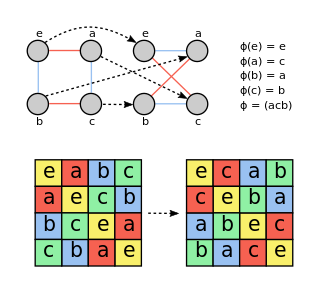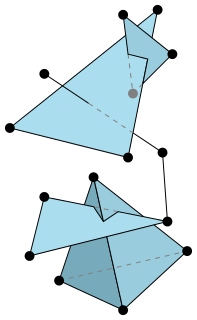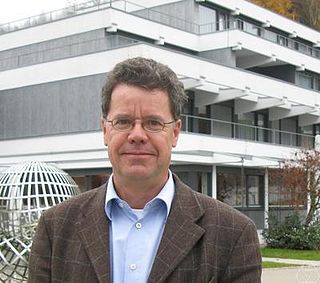Related Research Articles

In mathematics, an automorphism is an isomorphism from a mathematical object to itself. It is, in some sense, a symmetry of the object, and a way of mapping the object to itself while preserving all of its structure. The set of all automorphisms of an object forms a group, called the automorphism group. It is, loosely speaking, the symmetry group of the object.

Category theory formalizes mathematical structure and its concepts in terms of a labeled directed graph called a category, whose nodes are called objects, and whose labelled directed edges are called arrows. A category has two basic properties: the ability to compose the arrows associatively, and the existence of an identity arrow for each object. The language of category theory has been used to formalize concepts of other high-level abstractions such as sets, rings, and groups. Informally, category theory is a general theory of functions.
In category theory, a subobject classifier is a special object Ω of a category such that, intuitively, the subobjects of any object X in the category correspond to the morphisms from X to Ω. In typical examples, that morphism assigns "true" to the elements of the subobject and "false" to the other elements of X. Therefore, a subobject classifier is also known as a "truth value object" and the concept is widely used in the categorical description of logic. Note however that subobject classifiers are often much more complicated than the simple binary logic truth values {true, false}.
In mathematics, there is an ample supply of categorical dualities between certain categories of topological spaces and categories of partially ordered sets. Today, these dualities are usually collected under the label Stone duality, since they form a natural generalization of Stone's representation theorem for Boolean algebras. These concepts are named in honor of Marshall Stone. Stone-type dualities also provide the foundation for pointless topology and are exploited in theoretical computer science for the study of formal semantics.

In combinatorics, an abstract simplicial complex (ASC) is a family of sets that is closed under taking subsets, i.e., every subset of a set in the family is also in the family. It is a purely combinatorial description of the geometric notion of a simplicial complex. For example, in a 2-dimensional simplicial complex, the sets in the family are the triangles, their edges, and their vertices.
In mathematics, a simplicial set is an object made up of "simplices" in a specific way. Simplicial sets are higher-dimensional generalizations of directed graphs, partially ordered sets and categories. Formally, a simplicial set may be defined as a contravariant functor from the simplex category to the category of sets. Simplicial sets were introduced in 1950 by Samuel Eilenberg and Joseph A. Zilber.
In mathematics, a multicategory is a generalization of the concept of category that allows morphisms of multiple arity. If morphisms in a category are viewed as analogous to functions, then morphisms in a multicategory are analogous to functions of several variables. Multicategories are also sometimes called operads, or colored operads.
This is a glossary of properties and concepts in category theory in mathematics.
In mathematics, particularly in homotopy theory, a model category is a category with distinguished classes of morphisms ('arrows') called 'weak equivalences', 'fibrations' and 'cofibrations' satisfying certain axioms relating them. These abstract from the category of topological spaces or of chain complexes. The concept was introduced by Daniel G. Quillen (1967).
In mathematics, an operad is concerned with prototypical algebras that model properties such as commutativity or anticommutativity as well as various amounts of associativity. Operads generalize the various associativity properties already observed in algebras and coalgebras such as Lie algebras or Poisson algebras by modeling computational trees within the algebra. Algebras are to operads as group representations are to groups. An operad can be seen as a set of operations, each one having a fixed finite number of inputs (arguments) and one output, which can be composed one with others. They form a category-theoretic analog of universal algebra.
In category theory, a branch of mathematics, a PROP is a symmetric strict monoidal category whose objects are the natural numbers n identified with the finite sets and whose tensor product is given on objects by the addition on numbers. Because of “symmetric”, for each n, the symmetric group on n letters is given as a subgroup of the automorphism group of n. The name PROP is an abbreviation of "PROduct and Permutation category".
In mathematics, higher category theory is the part of category theory at a higher order, which means that some equalities are replaced by explicit arrows in order to be able to explicitly study the structure behind those equalities. Higher category theory is often applied in algebraic topology, where one studies algebraic invariants of spaces, such as their fundamental weak ∞-groupoid.
In category theory, a global element of an object A from a category is a morphism
In mathematics the cotangent complex is roughly a universal linearization of a morphism of geometric or algebraic objects. Cotangent complexes were originally defined in special cases by a number of authors. Luc Illusie, Daniel Quillen, and M. André independently came up with a definition that works in all cases.
In mathematics, a topos is a category that behaves like the category of sheaves of sets on a topological space. Topoi behave much like the category of sets and possess a notion of localization; they are a direct generalization of point-set topology. The Grothendieck topoi find applications in algebraic geometry; the more general elementary topoi are used in logic.

Izak (Ieke) Moerdijk is a Dutch mathematician, currently working at Utrecht University, who in 2012 won the Spinoza prize.
In mathematics, a highly structured ring spectrum or -ring is an object in homotopy theory encoding a refinement of a multiplicative structure on a cohomology theory. A commutative version of an -ring is called an -ring. While originally motivated by questions of geometric topology and bundle theory, they are today most often used in stable homotopy theory.
In mathematics, more specifically category theory, a quasi-category is a generalization of the notion of a category. The study of such generalizations is known as higher category theory.
In mathematics, a classifying topos for some sort of structure is a topos T such that there is a natural equivalence between geometric morphisms from a cocomplete topos E to T and the category of models for the structure in E.
In algebra, given a differential graded algebra A over a commutative ring R, the derived tensor product functor is
References
- Moerdijk, Ieke; Weiss, Ittay (2007), "Dendroidal sets", Algebraic & Geometric Topology, 7: 1441–1470, arXiv: math/0701293 , doi:10.2140/agt.2007.7.1441, ISSN 1472-2747, MR 2366165
- Dendroidal set in nLab